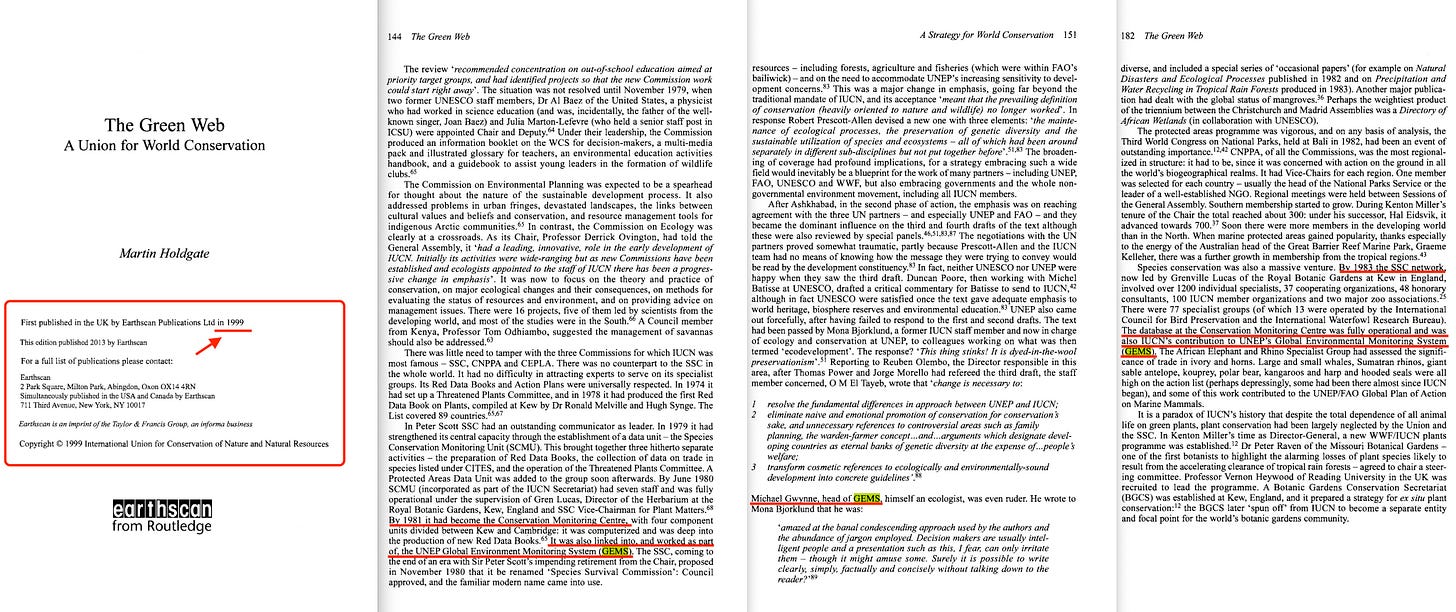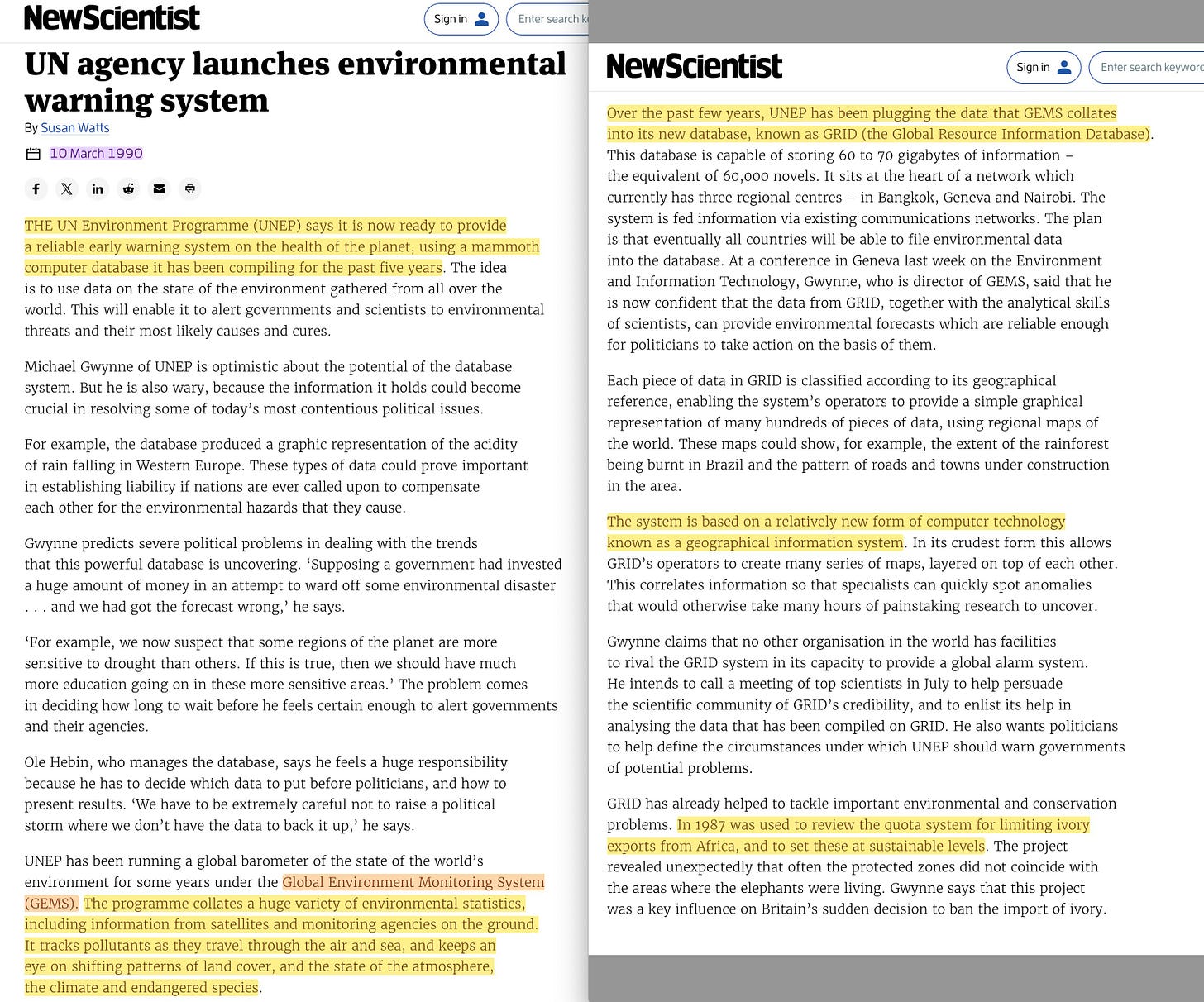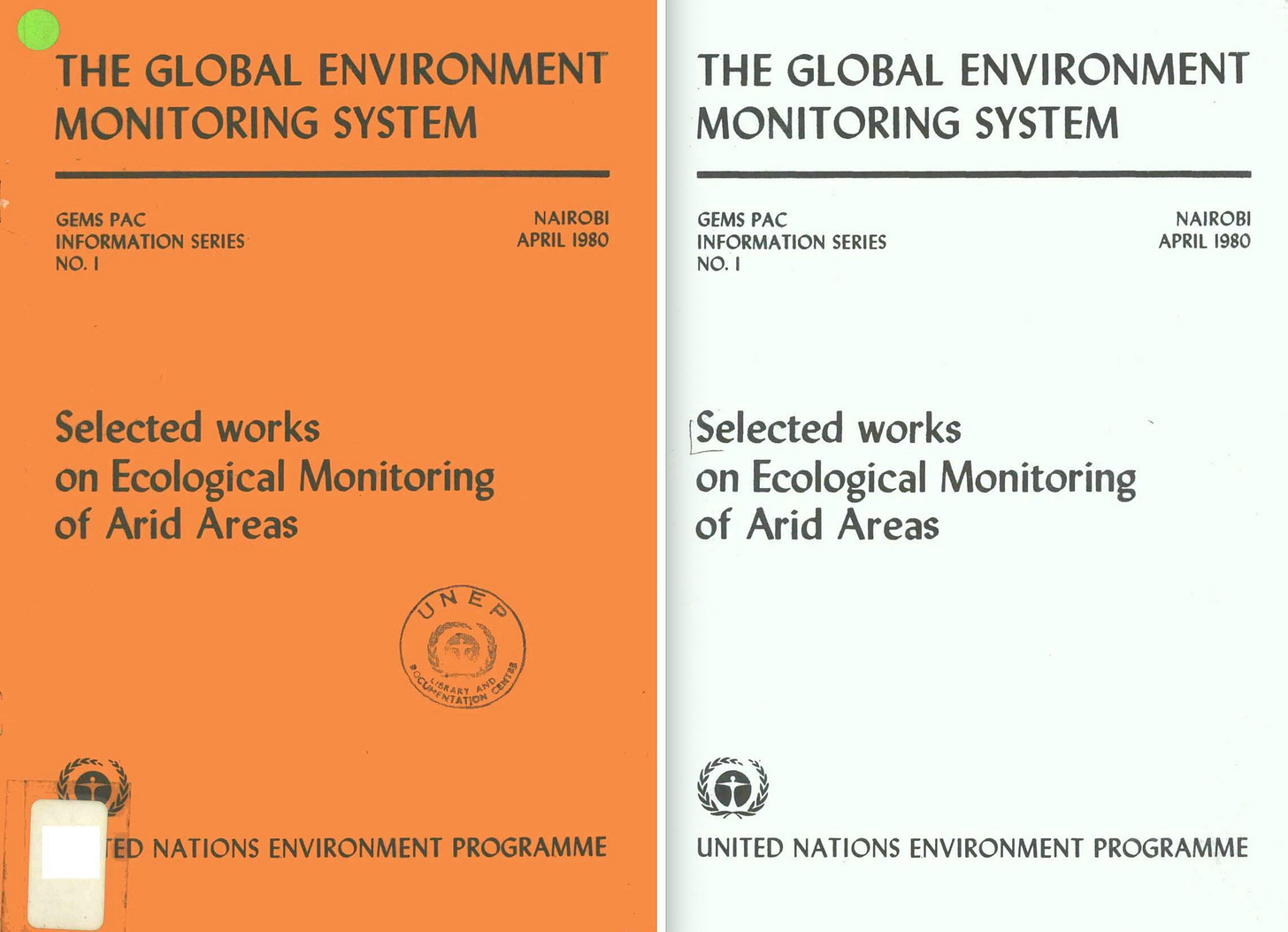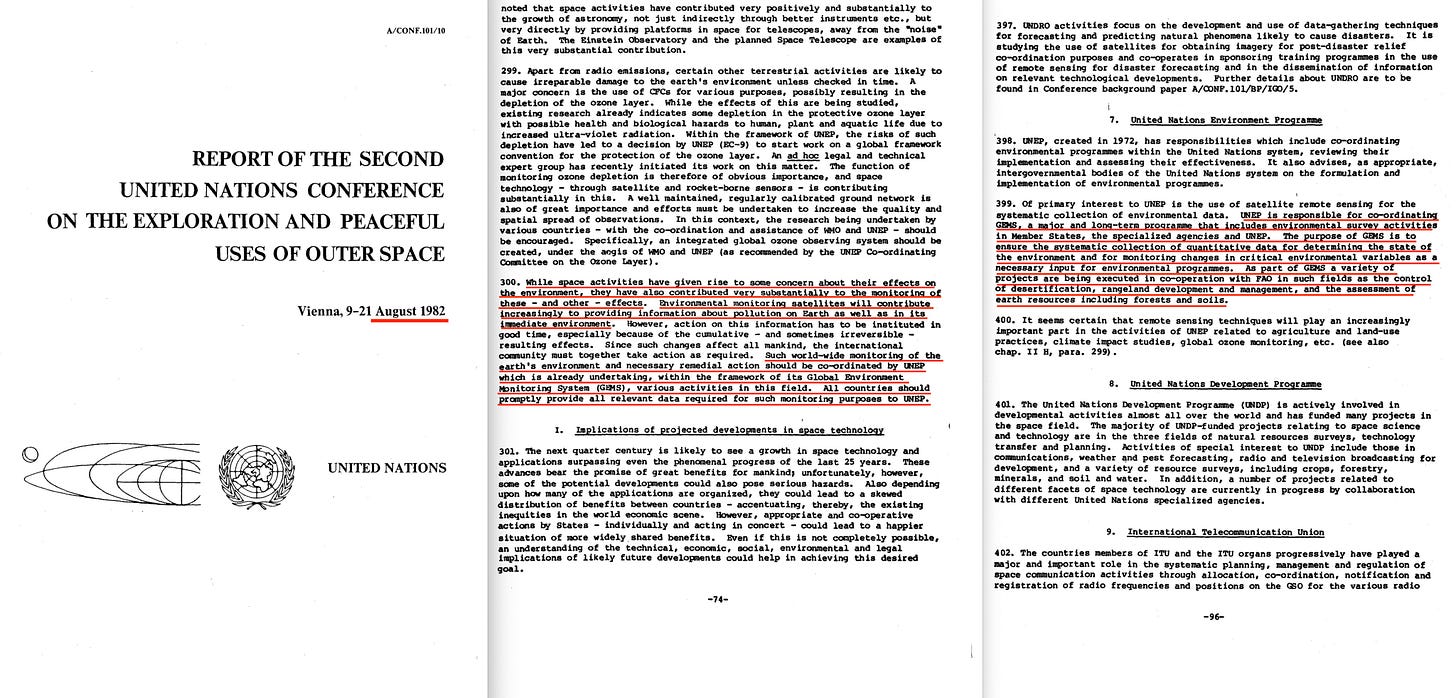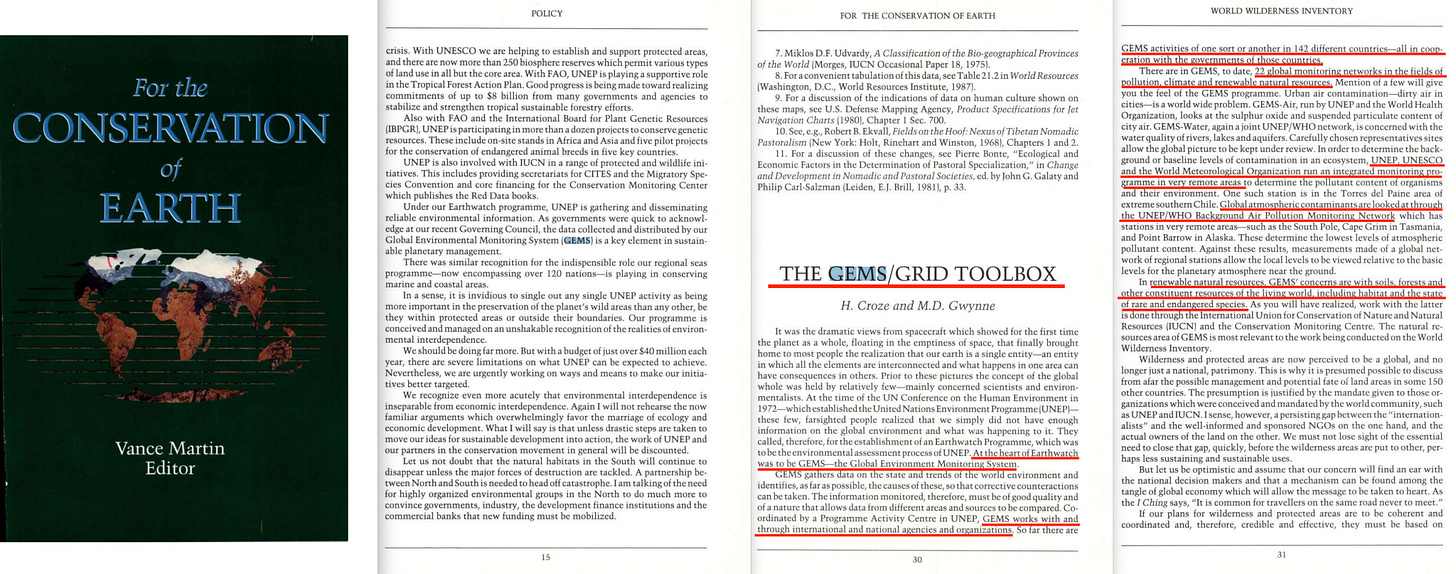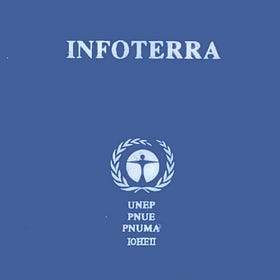Michael Gwynne, 1932-2012
UPDATE - added unclassified cables dragging in human health, the Rockefeller Foundation, SCOPE, and Henry Kissinger.
-
After a long illness, Michael Gwynne died in Nairobi on February 9, 2012.
He became the director of the UNEP programme; the Global Environmental Monitoring System, in 1978.
And their output - global surveillance - is now being integrated into legislation and policy, without your representatives ever honestly telling you about it.
-
On occasion, you discover an organisation whose presence is underwhelmingly covered by media and the various search engines. And should you find the occasional wayback link, often they are scrubbed as well. The Bank for International Settlements is a great example in that regard. Sure, search for what’s above board, and you’ll find, but look into who controls the enterprise and it’s a completely different ballgame.
GEMS is a such example. This is the third article on the topic, the second is here, and the first you can find through this link -
Global Environmental Monitoring System
This won’t be a long article. In fact, there’s really only one document I wish to source for this one, and it took hours to track down. Google? No. Wayback? No. Yahoo? No. Bing? No. I eventually started trying to guess the filename. After a handful of tries, I was in luck
In short, GEMS is a United Nations initiative, launched under Maurice Strong, to perform global surveillance - ostensibly for sakes of saving the environment, and thus, to protect us. But drill into detail, and you’ll discover that the scope of their mandate quickly widened during the early talks in the 1973-75 timeframe, with additions including biodiversity, epidemiology, and… human health.
And then, just as they’ve been given the green light by Maurice Strong & Co…. they disappear. Simply drop off the map. You’ll find the occasional link, like GEMS/Water documents from the 2010-20 timeframe, or GEMS/Air around 1990. Even the odd one related to food as well. But that’s pretty much it.
It’s at this stage you think… perhaps they were discontinued? Perhaps it was absorbed into other initiatives? Or finally… perhaps they took it underground?
And in that regard, let’s just remind ourselves that the whole point behind the launch of the UNEP was… fairly explicit.
Discontinuation appears the obvious starting point, because no other initiative comes into being at the time GEMS disappears. And further, there are some prominent signs of life later on, like a few 1985 UNEP reports -
Or even more importantly - in the 1987 Brundtland Report, Our Common Future -
And even yet another in the World Resources 1988-89 Report -
So there are some signs of life - but you’d expect GEMS to have more of a presence, given its hypothetical scale and potential impact.
And best as I went through the results of yet another search query, I found a link to a book, somewhat ironically released by the IUCN, titled ‘The Green Web, A Union for World Conservation’. It’s an interesting book, to which I will return, but the snippet of importance I found on page 151 - ‘Michael Gwynne, head of GEMS‘
And that’s of importance because it gives a high-ranking name, which then opens up whole new avenue of investigations - and boy, did that avenue bring a return.
Immediately, a link to a story carried by NewScientist in 1990 appeared, revealing that ‘The UN Environment Programme (UNEP) says it is now ready to provide a reliable early warning system on the health of the planet, using a mammoth computer database it has been compiling for the past five years.‘
‘UNEP has been running a global barometer of the state of the world’s environment for some years under the Global Environment Monitoring System (GEMS). The programme collates a huge variety of environmental statistics, including information from satellites and monitoring agencies on the ground‘
‘Over the past few years, UNEP has been plugging the data that GEMS collates into its new database, known as GRID (the Global Resource Information Database). This database is capable of storing 60 to 70 gigabytes of information…‘
‘The system is based on a relatively new form of computer technology known as a geographical information system. In its crudest form this allows GRID’s operators to create many series of maps, layered on top of each other. This correlates information so that specialists can quickly spot anomalies that would otherwise take many hours of painstaking research to uncover.‘
So it drags in GRID (to which we will return), geospatial information, satellite data… and monitoring agencies on the ground.
But that really was just the start of the show. Selecting some of the more noteworthy examples in this regard was this 1980 report, which the UNEP insisted was not on their server.
And then we have this report from the 1984 IUCN general assembly, revealing that -
‘The GEMS programme is large, involving some 30 global networks in the areas of climate, long-range transport of air pollution, health, oceans, and renewable natural resources. It is a very active programme in which most nations of the world participate.‘
So that drags in a range of those monitoring agencies on the ground - evidently, including health, as discussed in the official document I linked in the substack article above.
And already in 1984, most nations participated.
We also have a 1990 NewScientist article on water, and a 1996 Elsevier link on air pollution with mention of GEMS.
Then we have a link to a 1982 UN Conference on the Peaceful Exploration of Space, a 1988 report on the Conservation of Earth. yet another UNEP report on the Monitoring of nitrogen from 1991, and finally a 1988 Ghana newspaper article -
In 1988 the Washington Post covered the escalating pollution issue, and even divulged some detail in relation to GEMS -
‘Dr. Michael Gwynne, head of the GEMS system, said the report, covering air, water and food contamination, represents "the most comprehensive global study ever carried out."‘
And that also is telling, because food contamination requires a vastly different program to a system of global satellite imagery, and remote sensors.
And - though I have more - finally i wish to draw attention to the very first link post-revelation above - the story in NewScientist. Because it draws in the next component - GRID. The ‘Global Resource Information Database‘.
They were somewhat easier to track down. Here’s their mandate -
Did you catch that? Socio-economic variables. That would be the Determinants of Health, also outlined in prior articles.
And Agenda 21 is all over this document. Riddled. I’m sure A21 needs no introduction, so rather, let me show you their 1997-97 Programme elements instead.
Let me just point out that the word ‘management’ can be found 8 times in the above, and relates to the use of freshwater, coastal resources, river-basins, land-based sources, biological resources, environmental planning, sustainable cities, … and certainly not lease - financial services.
Which could then tie in the One Planet Summit, and specifically, the Network for Greening the Financial System. But that’s outside the scope of this article,
Additional now long-gone pages on GRID exist on wayback; here’s one from 1997; their home page, and their history, which details the 1972 Stockholm Conference, and the 1985 birth of GRID. It all ties in.
And finally, UNEPNet. Here’s a cached European version from 2002. Oh golly, and a Biodiversity Action Plan from 2003, which drags in the European Parliament, showing that - without the shadow of a doubt - not only is this initiative (GEMS) legit, but it is in fact being integrated into policy.
And yet - I bet - none of your representatives ever informed you thusly.
Why do you think that is?
-
UPDATE 1
Here’s a cable, specifically mentioning GEMS, sent on the 20th of September, 1974, titled ‘U.S. DESIGNATION OF BIOSPHERE RESERVES‘ and signed by KISSINGER.
-
UPDATE 2
1979 April 10 - UNEP GOVERNING COUNCIL DOCUMENT: EVALUATION & RESEARCH UNDER EARTHWATCH/GEMS
Another cable dragging in the Rockefeller Foundation, SCOPE, human health as well as the UNEP, GEMS, Earthwatch, and so forth.
-
GEMS wasn’t the only initiative out of Stockholm, 1972. What eventually cae to be known as INFOTERRA was another.
INFOTERRA; The International Referral System
Going through the documents related to GEMS, launched in the early 1970s and commissioned by none other than Maurice Strong, I repeatedly bumped into the ‘International Referral System’. I ignored it, repeatedly, but decided to take a quick look at what it’s all about.
And here’s a link to the first article on GEMS.
SCOPE
No, this isn’t a James Bond thriller. Perhaps it should be. - This story is about the third report out of an obscure committee going by the name of - ‘Scientific Committee on Problems of the Environment’ I have spent a lot of time investigating what led up to 2020, with a particular emphasis on










